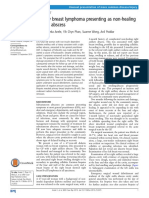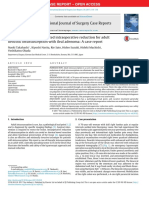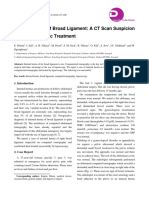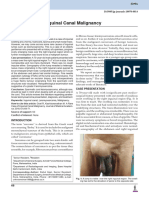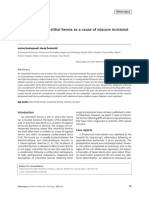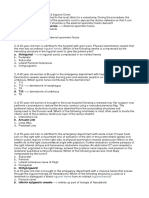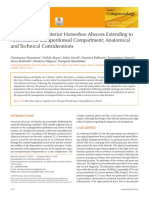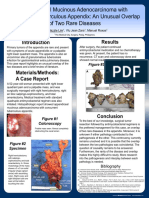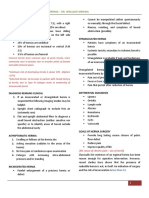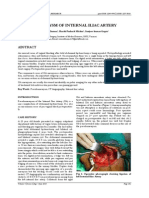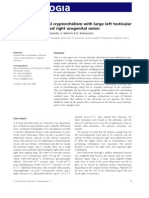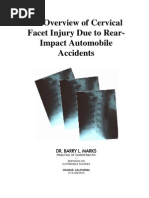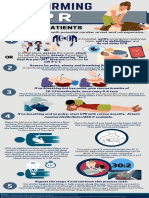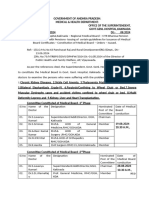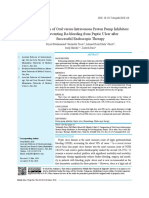Surgical Treatment of Cyst of The Canal of Nuck and Prevention of Lymphatic Complications: A Single-Center Experience
Surgical Treatment of Cyst of The Canal of Nuck and Prevention of Lymphatic Complications: A Single-Center Experience
Uploaded by
Jeje MoCopyright:
Available Formats
Surgical Treatment of Cyst of The Canal of Nuck and Prevention of Lymphatic Complications: A Single-Center Experience
Surgical Treatment of Cyst of The Canal of Nuck and Prevention of Lymphatic Complications: A Single-Center Experience
Uploaded by
Jeje MoOriginal Title
Copyright
Available Formats
Share this document
Did you find this document useful?
Is this content inappropriate?
Copyright:
Available Formats
Surgical Treatment of Cyst of The Canal of Nuck and Prevention of Lymphatic Complications: A Single-Center Experience
Surgical Treatment of Cyst of The Canal of Nuck and Prevention of Lymphatic Complications: A Single-Center Experience
Uploaded by
Jeje MoCopyright:
Available Formats
143
Lymphology 52 (2019) 143-148
SURGICAL TREATMENT OF CYST OF THE CANAL OF NUCK AND
PREVENTION OF LYMPHATIC COMPLICATIONS: A SINGLE-CENTER
EXPERIENCE
C. Cornacchia, S. Dessalvi, F. Boccardo
Department of Surgery - Unit of Lymphatic Surgery, University Hospital San Martino - University
School of Genoa, Italy
ABSTRACT of the uterus through the inguinal canal and
is analogous to a patent processus vaginalis
The canal of Nuck is a residue of the in males. If its obliteration fails, the result is
peritoneal evagination that runs along the a communication between the canal of Nuck
round ligament through the inguinal canal in and the peritoneal cavity that could cause an
women. Its partial or total patency can lead to indirect hernia or a cystic lymphangiomas
a cystic lymphangioma (CL). CL of the canal (CL). CL of the canal of Nuck may present as
of Nuck in an adult female is a rare entity a painless or painful, elastic, soft mass which
and its clinical diagnosis can be difficult or forms in the inguinal region. The recommend-
incorrect. Ultrasonography can be useful to ed treatment of the CL of the canal of Nuck
identify the nature of groin masses. A potential is surgical excision and closure of the inguinal
CL of the canal of Nuck should always be ring by an anterior open approach. Lymphatic
considered in the differential diagnosis of injuries following surgery in the inguinal re-
inguinal swelling in adult females. Even if it is gion have a relevant incidence in the literature
possible to consider conservative treatment, the (1-7).
optimal therapeutic option is surgical excision The inguinal region is a critical area
of the cystic mass and closure of the inguinal because of the anatomical characteristics of
ring by an anterior approach. In this study, we lymphatic distribution (8). In fact, the main
report a case series of four women affected by lymphatic bundle reaches the groin and even
a cyst of the canal of Nuck to underline the a minimal dissection of subcutaneous tissue
surgical treatment's therapeutic role of this in this area may cause significant lymphatic
pathological condition and the importance of damage (3). The most common lymphatic
preliminary identification of lymphatic vessels complications are lymphocele, lymphorrea,
with BPV (Blue Patent Violet) in order to lymphangitis, and lymphedema (1).
prevent lymphatic injuries such as lymphorrea
and lymphocele in the groin after surgery due MATERIALS AND METHODS
to the disruption of inguinal lymph nodes and
lymphatics. In this case series, we report four cases of
CL of the canal of Nuck in women surgically
Keywords: canal of Nuck; hydrocele; cystic treated in our center between 2017 and 2018.
lymphangioma; lymphatic surgery We identified four women aged 38 to 68
with the diagnosis of canal of Nuck cyst based
The canal of Nuck is the peritoneal fold on clinical examination and ultrasonography
that usually runs along the round ligament (US). Two patients were referred to MRI for
diagnostic confirmation.
Permission granted for single print for individual use.
Reproduction not permitted without permission of Journal LYMPHOLOGY.
144
Case 1 mass for one year. On physical examination,
the mass was soft, fixed on the deep level, and
A 68-year-old woman presented with there was ipsilateral inguinal lymphadenop-
one year of left inguinal swelling associated athy. Ultrasonography of the left inguinal
with ascites. The patient was also affected by region showed an anechoic fluid collection
lymphedema in the right limb and a cystic that partially changed in size on Valsalva
lymphangioma in the right thigh. The left maneuver. We surgically performed excision
groin region showed a mobile mass without of the Nuck cyst, preserving lymphatic vessels
evidence of incarceration or strangulation. by injecting Blue Patent Violet (BPV) dye into
Ipsilateral lymphadenopathy was present. The the left inguinal region ten minutes prior to
patient had undergone surgical treatment for surgery. The patient was discharged two days
bilateral crural hernia few years before. The after surgery and at six month follow-up had
US examination demonstrated a hypo-anecho- no recurrence of the cyst.
ic subcutaneous mass, consistent with a cyst
with some internal debris. A subsequent MRI Case 3
performed two months later showed multi-
loculated fluid collection in the left groin with A 41-year-old woman was referred to our
a maximum diameter of 9 cm (Fig. 1). The department for a painful cyclic right groin
patient was directed to surgery. A skin incision mass that appeared after intense exercise. The
was made in the left inguinal region. Through lump was mobile, elastic and painful on pal-
subcutaneous tissue and external oblique mus- pation. A conservative approach was unsuc-
cle it was possible to reach the inguinal canal. cessfully attempted, and surgical management
The cyst was carefully separated from the was undertaken. We identified and carefully
fibrotic tissue which had occurred as a result isolated the multiloculated cyst measuring
of the previous surgery. During the groin dis- 5x5x2 cm and performed surgical excision of
section, lymphatic collectors were highlighted the cyst of the canal of Nuck and closure of
in blue and were carefully spared. The Nuck the right inguinal ring by an anterior open
cyst contained clear fluid which was sent for approach. Lymphatic vessels were preserved
cytological examination and the presence of by injecting BPV dye into the right inguinal
amorphous material with erythrocytes, neutro- region a few minutes prior the surgery. The
phil granulocytes, lymphocytes and spumous
cells were observed. The histopathological
findings demonstrated thick-walled lymphatic
vessels in the cyst capsule. The cyst was com-
pletely separated from the round ligament,
excised completely and sent for hystopatho-
logical examination (Fig. 2). The patient was
discharged four days after surgery. At one year
follow-up, there was no recurrence of the mass
or ascites.
Case 2
A 38-year-old woman was referred to our
department for reducible swelling in her left
groin. She had complained of this painful Fig. 1. Axial T2-weighted image clearly shows the
hyperintense subcutaneous lesion within the left
inguinal canal.
Permission granted for single print for individual use.
Reproduction not permitted without permission of Journal LYMPHOLOGY.
145
mass was sent for hystopathological examina-
tion. The postoperative course was uneventful
and the patient was discharged three days
after surgery. At two-year follow-up, there was
no recurrence of the pathology.
Case 4
A 59-year-old woman presented with a
painful right groin mass. She had been com-
plaining about inguinal pain for a few months.
Physical examination revealed a palpable,
mobile mass with ipsilateral lymphadenopa-
thy. The initial US examination demonstrated
a cystic, anechoic structure in the right groin,
measuring at a maximum of 3.5 cm in size.
The patient was hospitalized because of onset
of abdominal pain. During hospitalization,
the swelling significantly decreased. A second
US examination showed a cystic mass in the
right groin measuring a maximum of only 2
cm in size with ipsilateral lymphadenopathy.
The subsequent MRI revealed a small, oval,
cyst measuring 2.3x1.6 cm with hypointense
T1 signal and hyperintense T2 signal charac-
teristics. A few days after the MRI, the patient
underwent surgery. Surgery started with a
right groin incision. After cutting the external
oblique aponeurosis, we dissected the cyst
from the round ligament and closed the canal
of Nuck at the inguinal deep ring. Lymphatic
vessels, previously colored in blue dye, were
carefully spared. Histopathological exam-
ination confirmed the diagnosis and showed
mesothelial cells on the cystic wall.
Fig. 2. A) The clinical examination revealed a mobile RESULTS
mass in the left groin with a maximum diameter of 9
cm. Below the mass, the site of the injection of BPV
in the left inguinal region. B) Surgical excision of the
The postoperative period of our patients
cyst of the canal of Nuck from the left groin. A pole of was satisfactory and uneventful. In all cas-
the cyst is connected to the round ligament. The fluid es, histopathological examination confirmed
collection can be appreciated by the translucency of the preoperative diagnosis and showed the
the cyst. C) After the complete excision of the cyst, a presence of a partially de-epithelialized cystic
surgical drain was placed and removed two days after
surgery. mass with fibrous walls, containing hemor-
rhage and lymphoplasmacytic and histiocytic
infiltrate. All patients were discharged a few
days after surgery. The prevention of lymphat-
ic injuries avoided the onset of surgery-related
Permission granted for single print for individual use.
Reproduction not permitted without permission of Journal LYMPHOLOGY.
146
early and late lymphatic complications. No groin masses are inguinal or femoral hernias,
patient had any recurrence of the pathology in enlarged lymph nodes, soft tissue tumors (lipo-
the follow-up period, which varied from six to mas, leiomyomas), Bartholin's cysts and en-
eighteen months. dometriosis of the round ligament. Other rare
causes of groin masses are arterial and venous
DISCUSSION aneurysms, ganglion cysts and paraspinal
abscesses surfacing in the groin (15,16).
The processus vaginalis peritonei, called However, the clinical history and imaging
"canal of Nuck" in the female, is a tubular findings (ultrasonography and MRI) can help
fold of the peritoneum that follows the round identify the nature of groin mass. High-reso-
ligament of the uterus as it passes through the lution sonography is a very accurate imaging
female inguinal canal (9). In males, the upper modality (17). In ultrasounds, the cyst of the
part usually closes at or just before birth and canal of Nuck appears as a tubular anechoic
obliteration proceeds gradually, while in fe- mass extending along the course of the round
males, the entire processus normally becomes ligament with a circumferential echogenic
obliterated (10). However, in some women margin, usually without any internal struc-
the canal of Nuck does not completely close tures (9,18). However, internal septations are
and if it remains completely patent, it forms a not uncommon and multiloculated cysts are
pathway for an indirect inguinal hernia. If the reported in the literature (13,16,19,20). Ultra-
obliteration is partial, fluid may also become sonography can be also a therapeutic instru-
trapped within the canal not communicating ment: US-guided drainage of the cyst has been
with the peritoneal cavity. This pathological reported in the literature as an effective proce-
condition is called the cyst of the canal of dure to provide immediate symptom relief (9).
Nuck, and it is represented by a cystic lymph- An MRI can give a conclusive diagnosis but it
angioma. Enlargement of the cyst is due to is more expensive than ultrasonography and
the hypersecretion or underabsorption of the can be avoided if the diagnosis can be made
secretory membrane that covers the processus by US. The first report of MRI findings in this
vaginalis. This imbalance may be a result of an condition described a cystic, thin-walled struc-
impairment of lymphatic drainage caused by ture in the inguinal region with hypointense
inflammation or trauma but in most cases it is T1 signal and hyperintense T2 signal charac-
idiopathic (9). teristics (21). During operation, the macro-
The diagnosis of a CL is often difficult scopical aspect of the lesion can confirm the
because this condition is rare and there are clinical and instrumental findings, and histo-
many differential diagnoses for groin masses. patological assessment finally defines the exact
Its incidence in adult females is not clear be- nature of the cyst. The usual pathological
cause there are few cases of cysts of the canal findings consist of the presence of hemorrhag-
of Nuck in the literature. Huang et al reported ic extravasation and lymphoplasmacytic-his-
that the incidence of this condition in children tiocytic infiltrate within the cystic wall. On the
is 1% (11). Sometimes the diagnosis is made other hand, only in some cases are lymphatic
during surgery performed for suspicious ingui- vessels demonstrated in the wall. It sould be of
nal hernias. Diagnosis is often entertained first interest to add immunohistochemical study of
because an inguinal hernia is present in one- the wall specifically to detect lymphatic vessels
third of the patients with a cyst of the canal endothelium. Even if it is possible to consider
of Nuck (12,13). The typical presentation of a a conservative treatment (aspiration, sclero-
cyst of the canal of Nuck is a painless or mod- therapy), the optimal therapeutic option is
erately painful fluctuant inguinal mass which surgical excision of symptomatic cysts of Nuck
is irreducible and can be transilluminated (14). because of the patency of duct of Nuck that
The most common differential diagnoses for leads to recurrence of the cyst after conserva-
Permission granted for single print for individual use.
Reproduction not permitted without permission of Journal LYMPHOLOGY.
147
tive treatment alone. varicose vein: Venodynamic and lymphody-
Surgical excision of the cyst was per- namic results. J. Vasc. Surg. 50 (2009), 1085-
1091.
formed using BPV injection distal to the
3. Dessalvi, S, G Villa, CC Campisi, et al: De-
surgical field in order to visualize lymphatic creasing and preventing lymphatic-injury-re-
vessels and avoid their injury. Lymphatic lated complications in patients undergoing
complications in the inguinal region after venous surgery: A new diagnostic and thera-
surgery are reported to be 15% (5,6). In our peutic protocol. Lymphology 51 (2018), 57-65.
4. Boccardo, F, M Valenzano, S Costantini, et
case series, BPV helped to visualize lymphatic al: LYMPHA technique to prevent secondary
vessels running next to the cyst mass during lower limb lymphedema. Ann. Surg. Oncol. 23
the approach. (2016), 3558-3563.
5. Boccardo, F, F De Cian, CC Campisi, et al:
CONCLUSIONS Surgical prevention and treatment of lymph-
edema after lymph node dissection in patients
with cutaneous melanoma. Lymphology 46
A painless, irreducible groin swelling in (2013), 20-26.
an adult female should include a possible cyst 6. Boccardo, F, CC Campisi, L Molinari, et al:
of the canal of Nuck among the differential Lymphatic complications in surgery: Possi-
diagnoses. Ultrasonography and MRI are the bility of prevention and therapeutic options.
Updates Surg. 64 (2015), 211-216).
imaging modalities of choice. Even if patients 7. Boccardo, F, S Dessalvi, C Campisi, et al:
choose conservative management when their Microsurgery for groin lymphocele and lymph-
symptoms are tolerable, surgery is the treat- edema after oncologic surgery. Microsurgery
ment of choice for a cyst of the canal of Nuck. 34 (2014), 10-13.
8. Schacht, V, W Luedemann, C Abels, et al:
Knowledge of the anatomical features of the
Anatomy of the subcutaneous lymph vascular
lymphatic collectors of this region is funda- network of the human leg in relation to the
mental to prevent lymphatic injury during great saphenous vein. Anat. Rec. (Hoboken)
surgery. A proper surgical technique, careful 292 (2009), 87-93.
dissection and use of blue dye to identify lym- 9. Stickel, WH, M Manner: Female hydrocele
(cyst of the canal of Nuck): Sonographic ap-
phatic structures, are of great importance to pearance of a rare and little-known disorder. J.
avoid lymphatic complications (3). Ultrasound Med. 23 (2004), 429-432.
This approach is needed to prevent and 10. Shadbolt, CL, SB Heinze, RB Dietrich: Im-
reduce the recurrence of the CL and the fre- aging of groin masses: Inguinal anatomy and
quency of post-operative lymphatic morbidity pathologic conditions revisited. Radiographics
21 (2001), Spec No:S261-271.
that is often long lasting and costly from a 11. Huang, CS, CC Luo, HC Chao, et al: The pre-
socio-healthcare point of view. sentation of asymptomatic palpable movable
mass in female inguinal hernia. Eur. J. Pediatr.
CONFLICT OF INTEREST AND DISCLO- 162 (2003), 493-495.
SURE 12. Block, RE: Hydrocele of the canal of Nuck: A
report of five cases. Obstet. Gynecol. 45 (1995),
464-466.
The authors declare no competing finan- 13. Miklos, JR, MM Karram, E Silver, et al:
cial interests exist. Ultrasound and hookwire needle placement
for localization of a hydrocele of the canal of
Nuck. Obstet. Gynecol. 85 (1995), 884-886.
REFERENCES
14. Patnam, V, R Narayanan, A Kudva: A caution-
ary approach to adult female groin swelling:
1. Pittaluga, P, S Chastanet: Lymphatic complica- Hydrocoele of the canal of Nuck with a review
tions after varicose veins surgery: Risk factors of the literature. BMJ Case Rep. (2016),
and how to avoid them. Phlebology 27 (2012) 2016:bcr2015212547.
Suppl 1, 139-142. 15. Kucera, PR, J Glazer: Hydrocele of the canal
2. Suzuki, M, N Unno, N Yamamoto, et al: of Nuck: A report of 4 cases. J. Reprod. Med.
Impaired lymphatic function recovered after 30 (1985), 439- 442.
great saphenous vein stripping in patients with
Permission granted for single print for individual use.
Reproduction not permitted without permission of Journal LYMPHOLOGY.
148
16. Schneider, CA, S Festa, CR Spillert, et al: 20. Rathaus, V, O Konen, M Shapiro, et al: Ultra-
Hydrocele of the canal of Nuck. N.J. Med. 91 sound features of spermatic cord hydroceles in
(1994), 37-38. children. Br. J. Radiol. 74 (2001), 818-820.
17. Ozel, A, O Kirdar, AM Halefoglu, et al: Cysts 21. Park, SJ, HK Lee, HS Hong, et al: Hydrocele
of the canal of Nuck: Ultrasound and magnetic of the canal of Nuck in a girl: Ultrasound and
resonance imaging findings. J. Ultrasound 12 MR appearance. Br. J. Radiol. 77 (2004), 243-
(2009), 125-127. 244.
18. Anderson, CC, TA Broadie, JE Mackey, et al:
Hydrocele of the canal of Nuck: Ultrasound
appearance. Am. Surg. 61 (1995), 959-961. Francesco Boccardo, MD, PhD, FACS
19. McElfatrick, RA, WB Condon: Hydrocele of Department of Surgery -
the canal of Nuck: A report of 2 cases. Rocky Unit of Lymphatic Surgery
Mt. Med. J. 72 (1975), 112-113. University Hospital San Martino -
University School of Genoa, Italy
Largo R. Benzi 10
16132 Genoa, Italy
Telephone: +393356257183
Fax: +39010532778
E-mail: francesco.boccardo@unige.it
Permission granted for single print for individual use.
Reproduction not permitted without permission of Journal LYMPHOLOGY.
You might also like
- Topnotch Pediatrics For MoonlightersDocument323 pagesTopnotch Pediatrics For Moonlightersmefav7778520100% (1)
- Heal Your Eye Problems With Herbs, Minerals and Vitamins PDFDocument144 pagesHeal Your Eye Problems With Herbs, Minerals and Vitamins PDFangelobuffalo100% (9)
- Deep Vein ThrombosisDocument5 pagesDeep Vein Thrombosisampogison08No ratings yet
- 2021 J.chirDocument4 pages2021 J.chircorinaNo ratings yet
- An Unusual Cause of "Appendicular Pain" in A Young Girl: Mesenteric Cystic LymphangiomaDocument3 pagesAn Unusual Cause of "Appendicular Pain" in A Young Girl: Mesenteric Cystic LymphangiomaSherif Abou BakrNo ratings yet
- Europian Surgical Abstract 2 PDFDocument114 pagesEuropian Surgical Abstract 2 PDFDrAmmar MagdyNo ratings yet
- Utd 13 1 74 77Document4 pagesUtd 13 1 74 77Abhishek Soham SatpathyNo ratings yet
- Jurnal AbsesDocument4 pagesJurnal AbsesRay HannaNo ratings yet
- Case Report: Giant Abdomino Scrotal Hydrocele: A Case Report With Literature ReviewDocument6 pagesCase Report: Giant Abdomino Scrotal Hydrocele: A Case Report With Literature ReviewMella IntaniabellaNo ratings yet
- Fallopian Tube HerniationDocument4 pagesFallopian Tube HerniationAliyaNo ratings yet
- Bariatric SurgeryDocument4 pagesBariatric SurgeryCla AlsterNo ratings yet
- 1 s2.0 S2210261221012268 MainDocument4 pages1 s2.0 S2210261221012268 Mainzenatihanen123No ratings yet
- Release of Obstructing Rectal Cuff Following Transanal Endorectal Pullthrough For Hirschsprung's Disease: A Laparoscopic ApproachDocument3 pagesRelease of Obstructing Rectal Cuff Following Transanal Endorectal Pullthrough For Hirschsprung's Disease: A Laparoscopic ApproachAlia AsgharNo ratings yet
- Laparoscopy AbscesoDocument7 pagesLaparoscopy AbscesoMedardo ApoloNo ratings yet
- Unusual Presentation of Recurrent Appendicitis - A Rare Case Report and Literature ReviewDocument4 pagesUnusual Presentation of Recurrent Appendicitis - A Rare Case Report and Literature ReviewMirachel AugustNo ratings yet
- International Journal of Surgery Case ReportsDocument3 pagesInternational Journal of Surgery Case Reportscindy315No ratings yet
- Post-Caesarean Rectus Sheath HaematomaDocument4 pagesPost-Caesarean Rectus Sheath HaematomatapayanaNo ratings yet
- Internal Hernia of Broad Ligament: A CT Scan Suspicion and Laparoscopic TreatmentDocument4 pagesInternal Hernia of Broad Ligament: A CT Scan Suspicion and Laparoscopic TreatmentSabrina JonesNo ratings yet
- Fistula-In-Ano Extending To The ThighDocument5 pagesFistula-In-Ano Extending To The Thightarmohamed.muradNo ratings yet
- 1.case Report-A Rare Case of Inguinal Canal MalignancyDocument4 pages1.case Report-A Rare Case of Inguinal Canal Malignancyunknownsince1986No ratings yet
- A Case of Atypical Course of Femoral HerniaDocument2 pagesA Case of Atypical Course of Femoral HerniaKamal GpNo ratings yet
- Wiitm 7 17104 PDFDocument4 pagesWiitm 7 17104 PDFZam HusNo ratings yet
- Hetero Topic Pregnancy in A Natural Conception Cycle Presenting As HeDocument82 pagesHetero Topic Pregnancy in A Natural Conception Cycle Presenting As Hes355517No ratings yet
- Skipidip Skipidap Colonic Hernia YyeewaghDocument4 pagesSkipidip Skipidap Colonic Hernia YyeewaghSu-sake KonichiwaNo ratings yet
- Glimpses On Rare Cases of Thigh Swellings - A Case SeriesDocument5 pagesGlimpses On Rare Cases of Thigh Swellings - A Case SeriesInternational Journal of Innovative Science and Research TechnologyNo ratings yet
- BLOCK II LMS Quiz AnatomyDocument27 pagesBLOCK II LMS Quiz AnatomyAshley BuchananNo ratings yet
- Tubo-Ovarian Abscess in A Virgin Girl: Case ReportDocument4 pagesTubo-Ovarian Abscess in A Virgin Girl: Case ReportMaria MiripNo ratings yet
- Ma 07004Document5 pagesMa 07004Lilik PrasajaNo ratings yet
- The Rare TravellersDocument3 pagesThe Rare TravellersPedro TrigoNo ratings yet
- 191 FullDocument3 pages191 FullPaediatrics CMC VelloreNo ratings yet
- Treatment of Mesh-Associated Abscess Using An Incision-Free Technique: A Case SeriesDocument4 pagesTreatment of Mesh-Associated Abscess Using An Incision-Free Technique: A Case SeriesMiyako 12No ratings yet
- Mucinous Neoplasm of Appendix TreatmentDocument3 pagesMucinous Neoplasm of Appendix TreatmentInternational Journal of Innovative Science and Research TechnologyNo ratings yet
- Absceso 1Document5 pagesAbsceso 1roger alcantaraNo ratings yet
- Huge Mediastinal Ancient Schwannoma Causing AcuteDocument6 pagesHuge Mediastinal Ancient Schwannoma Causing AcuteBarbara SouzaNo ratings yet
- Symptomatic Lymphangioma of The Adrenal Gland: A Case ReportDocument3 pagesSymptomatic Lymphangioma of The Adrenal Gland: A Case Reportjulio perezNo ratings yet
- 1 s2.0 S2210261215001157 MainDocument4 pages1 s2.0 S2210261215001157 MainsindujasaravananNo ratings yet
- Colocutaneous Poster - New PDFDocument1 pageColocutaneous Poster - New PDFMohammadMasoomParwezNo ratings yet
- Unit13 Anatomy MCQsDocument50 pagesUnit13 Anatomy MCQsAsadullah Yousafzai100% (2)
- 1 PB PDFDocument4 pages1 PB PDFTushar SinghNo ratings yet
- Cystic Hygroma of The Neck: Single Center Experience and Literature ReviewDocument6 pagesCystic Hygroma of The Neck: Single Center Experience and Literature ReviewLiv InkNo ratings yet
- Appendiceal Mucinous Adenocarcinoma With Concurrent Tuberculous Appendix: An Unusual Overlap of Two Rare DiseasesDocument1 pageAppendiceal Mucinous Adenocarcinoma With Concurrent Tuberculous Appendix: An Unusual Overlap of Two Rare DiseasesKhei Jazzle LimNo ratings yet
- Template 1Document3 pagesTemplate 1Mohd KhalilNo ratings yet
- Case Report Actinomyces Meyeri Popliteal Cyst Infection And: Review of The LiteratureDocument6 pagesCase Report Actinomyces Meyeri Popliteal Cyst Infection And: Review of The LiteraturekiranNo ratings yet
- PDF Sequence 1Document5 pagesPDF Sequence 1Hermawan Pramudya IINo ratings yet
- Hernia 2015Document9 pagesHernia 2015Ann Ross VidalNo ratings yet
- Splenectomy in Special CasesDocument5 pagesSplenectomy in Special CasesScivision PublishersNo ratings yet
- Rare Sigmoid Abdominal Wall Fistula After Appendectomy: A Case ReportDocument6 pagesRare Sigmoid Abdominal Wall Fistula After Appendectomy: A Case Reportjlcano1210No ratings yet
- Krukenberg Tumour Simulating Uterine Fibroids and Pelvic Inflammatory DiseaseDocument3 pagesKrukenberg Tumour Simulating Uterine Fibroids and Pelvic Inflammatory DiseaseradianrendratukanNo ratings yet
- Ijmshr 02 95Document5 pagesIjmshr 02 95guitellesNo ratings yet
- 4 2 - 181 182 PDFDocument2 pages4 2 - 181 182 PDFNam LeNo ratings yet
- Conventional Versus Laparoscopic Surgery For Acute AppendicitisDocument4 pagesConventional Versus Laparoscopic Surgery For Acute AppendicitisAna Luiza MatosNo ratings yet
- Absceso Esplenico 1Document2 pagesAbsceso Esplenico 1Luis Alfredo LucioNo ratings yet
- Journal of Pediatric Surgery Case Reports: Wandering Mesenteric CystDocument4 pagesJournal of Pediatric Surgery Case Reports: Wandering Mesenteric CysthilalNo ratings yet
- From The James Buchanan Brady Urological Institute, Johns Hopkins Hospital, BaltimoreDocument8 pagesFrom The James Buchanan Brady Urological Institute, Johns Hopkins Hospital, BaltimoreFristune NewNo ratings yet
- Large Nabothian Cyst With Chronic Pelvic Pain - Case Report and Literature ReviewDocument3 pagesLarge Nabothian Cyst With Chronic Pelvic Pain - Case Report and Literature ReviewCipiripi CipiripiNo ratings yet
- Anterior Ultrasound-Guided Superior Hypogastric Plexus Neurolysis in Pelvic Cancer PainDocument4 pagesAnterior Ultrasound-Guided Superior Hypogastric Plexus Neurolysis in Pelvic Cancer PainWidya AriatyNo ratings yet
- Tissue of The Causing Referred Pain The Leg: Primary TumoursDocument4 pagesTissue of The Causing Referred Pain The Leg: Primary TumoursantonioopNo ratings yet
- Ginek3 PDFDocument3 pagesGinek3 PDFberlinaNo ratings yet
- Case Report Aditya - Jurnal VancoverDocument6 pagesCase Report Aditya - Jurnal VancoverAditya AirlanggaNo ratings yet
- Bilateral Abdominal Cryptorchidism With Large Left Testicular Seminoma and Failed Right Urogenital UnionDocument4 pagesBilateral Abdominal Cryptorchidism With Large Left Testicular Seminoma and Failed Right Urogenital UnionMagdi HassanNo ratings yet
- Chin 2007Document3 pagesChin 2007sbm3.enggNo ratings yet
- Transluminal Endoscopic Necrosectomy After Acute Pancreatitis: A Multicentre Study With Long-Term Follow-Up (The GEPARD Study)Document8 pagesTransluminal Endoscopic Necrosectomy After Acute Pancreatitis: A Multicentre Study With Long-Term Follow-Up (The GEPARD Study)victorNo ratings yet
- Intermediary Details Name Code Contact Number Care Health Insurance Ltd. DirectDocument7 pagesIntermediary Details Name Code Contact Number Care Health Insurance Ltd. Directmoyazbin hoqueNo ratings yet
- Brain AbscessDocument45 pagesBrain AbscessAnanda AsmaraNo ratings yet
- SEPTEMBER 6, 2021 Hematology Assessment: Characteristic FeaturesDocument23 pagesSEPTEMBER 6, 2021 Hematology Assessment: Characteristic FeaturesChristian John V. CamorahanNo ratings yet
- GROUP 3 - Assignment-4 - Medically-Significant-VirussDocument42 pagesGROUP 3 - Assignment-4 - Medically-Significant-VirussJade SarduaNo ratings yet
- 4 Mezil & Abed, 2021 Review - Complication of Diabetes MellitusDocument12 pages4 Mezil & Abed, 2021 Review - Complication of Diabetes Mellitusbangd1f4nNo ratings yet
- Facet Joint Injuries From Car AccidentsDocument13 pagesFacet Joint Injuries From Car AccidentsBarry Marks, DC100% (1)
- Final-OPIDO (SN) - BSN 407 - CPRDocument1 pageFinal-OPIDO (SN) - BSN 407 - CPRrodolfo opidoNo ratings yet
- Preseptal Cellulitis y OrbitariaDocument18 pagesPreseptal Cellulitis y OrbitariaMario Mendoza TorresNo ratings yet
- Adenosine Deaminase: Quantitative Determination of Adenosine Deaminase (ADA) in Serum and Plasma SamplesDocument1 pageAdenosine Deaminase: Quantitative Determination of Adenosine Deaminase (ADA) in Serum and Plasma Samplesmark.zac1990No ratings yet
- Hunter Syndrome A Case ReportDocument4 pagesHunter Syndrome A Case ReportResearch ParkNo ratings yet
- Dapus LPDocument5 pagesDapus LPintan nurhalizaNo ratings yet
- Automated Detection of Sleep Apnoea Ecg Signals Using Non-Linear ParametersDocument63 pagesAutomated Detection of Sleep Apnoea Ecg Signals Using Non-Linear ParametersJhoel Eusebio Parraga IsidroNo ratings yet
- Patient Registry: Annual Data ReportDocument32 pagesPatient Registry: Annual Data ReportekaNo ratings yet
- Hashimoto's Triggers-Advanced Reader Copy-V2Document332 pagesHashimoto's Triggers-Advanced Reader Copy-V2Anonymous XiymFuQdF100% (2)
- NTR BharosaDocument11 pagesNTR BharosaTalabathulaSlnmurthyNo ratings yet
- Ira Aranda - Science Reading Article 13 - Miraculous Medical MaggotsDocument2 pagesIra Aranda - Science Reading Article 13 - Miraculous Medical Maggotsarandaira3No ratings yet
- 8 Supplements To Repair A Leaky GutDocument9 pages8 Supplements To Repair A Leaky GutalbinutaNo ratings yet
- Medical Helminthology Introduction PDFDocument13 pagesMedical Helminthology Introduction PDFfaiz0% (1)
- Comparison of Oral Versus Intravenous Proton Pump InhibitorsDocument6 pagesComparison of Oral Versus Intravenous Proton Pump InhibitorsirsyadilfikriNo ratings yet
- Neonatal Varicella: A Case ReportDocument15 pagesNeonatal Varicella: A Case ReportArum Ardisa RiniNo ratings yet
- Biosafety Levels and Risk Group OrganismsDocument29 pagesBiosafety Levels and Risk Group OrganismsJyotiNo ratings yet
- NCP (Ulcerative Colitis)Document13 pagesNCP (Ulcerative Colitis)Jay Jay JayyiNo ratings yet
- Star Super Surplus Floater BrochureDocument2 pagesStar Super Surplus Floater BrochureqcselvaNo ratings yet
- Laporan Pemantauan Terapi Obat 2022Document728 pagesLaporan Pemantauan Terapi Obat 2022hamidahNo ratings yet
- Cleo - Agustin - Pathophysiology of SarcoidosisDocument1 pageCleo - Agustin - Pathophysiology of SarcoidosisCleobebs AgustinNo ratings yet
- Module 1 QuizDocument7 pagesModule 1 QuizkasinarayananjrNo ratings yet








